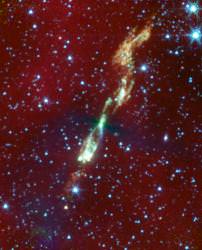It’s always exciting to see an idea in theory verified with real observations. For the first time, astronomers have observed a theoretical stage in stellar evolution, when a star’s envelope is beginning to flatten and collapse, and streams of gas are escaping out. New observations by NASA’s Spitzer Space Telescope have spotted a young star right at this stage, blasting out material in powerful jets.
The new research will be published in the December 1st edition of Astrophysical Journal Letters. It provides observational evidence to this specific stage in the currently accepted model of stellar evolution.
Researchers from several universities observed a newly forming star called L1157, located about 800 light-years away in the constellation Cepheus. The star is only 10,000 years old, and still has a million years or so to go before it ignites as a star like our Sun.
New stars are born out of vast clouds of cold gas and dust. As the collective gravity of the gas pulls inward, the whole collection starts to spin. As the star grows in the middle, it spins faster and faster, and a disk of planet-forming material forms around it. Powerful jets fire off from the top and bottom of the star to relieve its accumulating pressure. Eventually the envelope of material falls onto the spinning disk, and the jets halt.
Here’s the problem in watching this process: dust. Newborn stars are surrounded in a halo of dust that visible light telescopes can’t penetrate. Fortunately, the infrared view of telescopes like Spitzer can see right through the dust, to learn what’s going on inside.
The twin jets blasting off of L1157 are huge; each one is .75 light years long. The hottest parts of the jet (seen in white in the image) are about 100 degrees Celsius (212 degrees F), but the remainder is down around zero.
The planetary disk itself is the dark band in the middle of the image, dark and hazy. In fact, it’s clogged with so much dust that not even Spitzer can see through it.
Original Source: NASA/JPL/Spitzer News Release

